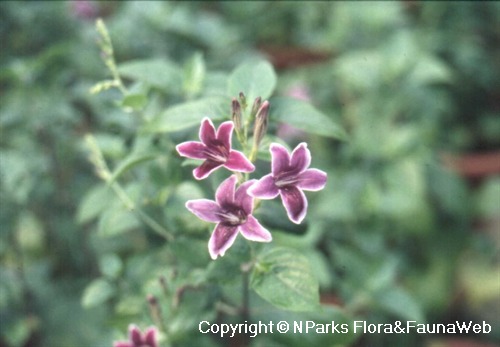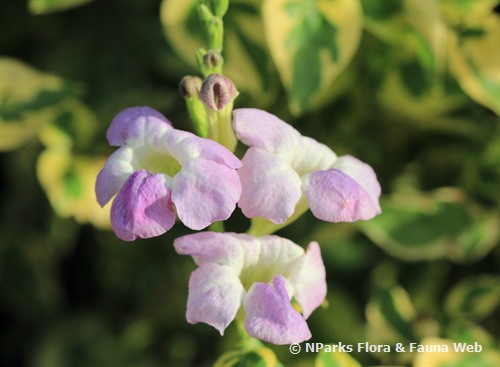
Name
Classifications and Characteristics
| Plant Division | Angiosperms (Flowering Seed Plants) (Dicotyledon) |
|---|---|
| Plant Growth Form | Shrub |
Biogeography
| Native Distribution | Malaysia |
|---|
Description and Ethnobotany
| Growth Form | A perennial herbaceous plant growing up to 1 m tall. |
|---|---|
| Foliage | Leaf blade ovate to lanceolate, measuring 6-12 x 3-5 cm, pilose on underside of leaf along the veins, glabrous or pilose on upper side of leaf along the veins, apex acuminate, base attenuate, margin undulate-crenulate. |
| Stems | Pilose stem. |
| Flowers | Raceme, terminal or axillary, measures 5 - 9 cm; bracts are triangular, pilose; pedicel 1-2 mm; calyx (sepal) 5-6 mm, lanceolate lobes; corolla (petal) red to purple-red, lobes ovate. |
| Fruit | Capsule, measures 1.8 -2.2 cm. Seeds irregular obovate. |
| Ethnobotanical Uses | Food (Fruit or Vegetable) |
Landscaping Features
| Desirable Plant Features | Ornamental Flowers |
|---|
Fauna, Pollination and Dispersal
| Fauna Pollination Dispersal Associated Fauna | Butterfly Host Plant, Butterfly-Attracting |
|---|
Plant Care and Propagation
| Light Preference | Semi-Shade, Full Sun |
|---|---|
| Water Preference | Moderate Water |
| Rootzone Tolerance | Drought Tolerant, Well-Drained Soils |
Foliar
| Foliage Retention | Evergreen |
|---|---|
| Mature Foliage Colour(s) | Green |
| Foliar Type | Simple / Unifoliate |
| Foliar Shape(s) | Non-Palm Foliage (Ovate, Lanceolate) |
| Foliar Venation | Pinnate / Net |
| Foliar Margin | Entire - Wavy / Undulate, Crenulate |
| Foliar Apex - Tip | Acuminate |
| Foliar Base | Attenuate |
| Leaf Area Index (LAI) for Green Plot Ratio | 4.5 (Shrub & Groundcover - Dicot) |
Floral (Angiosperm)
| Flower & Plant Sexuality | Bisexual Flowers |
| Flower Colour(s) | Purple |
|---|---|
| Flower Texture(s) | Smooth |
| Flower Grouping | Cluster / Inflorescence |
| Flower Location | Axillary, Terminal |
| Inflorescence Type | Raceme |
Image Repository
Others
| Master ID | 411 |
|---|---|
| Species ID | 1707 |
| Flora Disclaimer | The information in this website has been compiled from reliable sources, such as reference works on medicinal plants. It is not a substitute for medical advice or treatment and NParks does not purport to provide any medical advice. Readers should always consult his/her physician before using or consuming a plant for medicinal purposes. |





